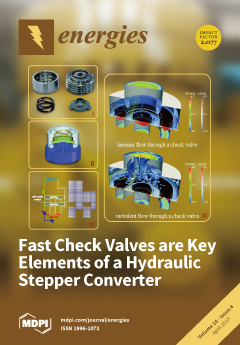High performance flexible inverted organic solar cells (OSCs) employing the low temperature cathode buffer bilayer combining the aqueous solution-processed ZnO and polyethylenimine ethoxylated (PEIE) are investigated based on Poly(3-hexylthiophene-2,5-diyl):[6,6]-phenyl-C
61-butryric acid methyl ester (P3HT:PC
61BM) and Poly({4,8-bis[(2-ethylhexyl)oxy]benzo[1,2-b:4,5-b′]dithiophene-2,6-diyl}{3-fluoro-2-[(2-ethylhexy)carbonyl]thieno[3,4-b]thiophenediyl}):[6,6]-phenyl-C
71-butyric acid methyl
[...] Read more.
High performance flexible inverted organic solar cells (OSCs) employing the low temperature cathode buffer bilayer combining the aqueous solution-processed ZnO and polyethylenimine ethoxylated (PEIE) are investigated based on Poly(3-hexylthiophene-2,5-diyl):[6,6]-phenyl-C
61-butryric acid methyl ester (P3HT:PC
61BM) and Poly({4,8-bis[(2-ethylhexyl)oxy]benzo[1,2-b:4,5-b′]dithiophene-2,6-diyl}{3-fluoro-2-[(2-ethylhexy)carbonyl]thieno[3,4-b]thiophenediyl}):[6,6]-phenyl-C
71-butyric acid methyl ester (PTB-7:PC
71BM) material systems. It is found that, compared with pure ZnO or PEIE cathode buffer layer (CBL), the proper combination of low-temperature processed ZnO and PEIE as the CBL enhanced the short circuit current density (
JSC), resulting in better device performance. The increased
JSC results from the enhanced electron collection ability from the active layer to the cathode. By using the ZnO/PEIE CBL, a power conversion efficiency (
PCE) as high as 4.04% for the P3HT:PC
61BM flexible device and a
PCE as high as 8.12% for the PTB-7:PC
71BM flexible device are achieved, which are higher than the control devices with the pure ZnO CBL or pure PEIE CBL. The flexible inverted OSC also shows a superior mechanical property and it can keep 92.9% of its initial performance after 1000 bending cycles with a radius of 0.8 cm. These results suggest that the combination of the low temperature aqueous solution processed ZnO and PEIE can be a promising cathode buffer bilayer for flexible inverted OSCs.
Full article





